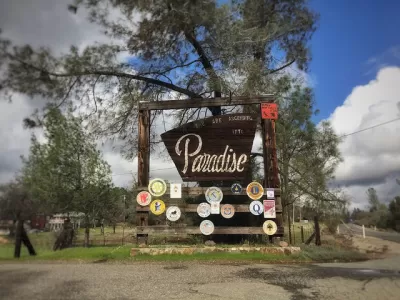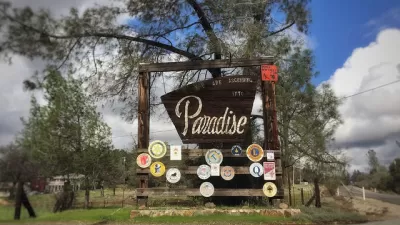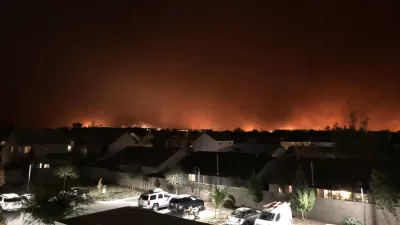Paradise is the largest incorporated city west of the Mississippi River lacking a public sewer system. The town of of 27,000 relies on septic systems, now potentially damaged. Without sewers, multi-family housing construction becomes more difficult.

The lack of sewers hampers economic and housing development and threatens water supplies with pollution from failing septic systems. A sewer project feasibility report was released two years ago, something that will have to be considered in the rebuilding efforts. But the first order of business is cleanup from California's largest and deadliest wildfire.
"The colossal effort to clear Butte County of the rubble, and make way for recovery of the town of Paradise and its neighbors, is expected to last at least a year," reports Kurtis Alexander for the San Francisco Chronicle. "The trucks and trains being mobilized for the work are prepared to take out as much as 8 million tons of material — almost four times what was removed from last year’s Northern California fires."
Alexander describes various aspects of dealing with all the hazardous materials caused by the Camp Fire, which killed at least 85 people, including "how potentially damaged septic systems in Paradise could harm the landscape."
“It appears that Paradise is the largest incorporated city west of the Mississippi that is wholly dependent on septic systems,” the town’s then-vice mayor, Jody Jones, who is now mayor, told Chico City Council members at their meeting on Sept. 1, 2015, reported Robert Speer for the Chico News and Review. “This is not something to be proud of.”
Hooking up with the Chico sewer system was the Paradise Town Council's preferred alternative among three listed.
Dealing with potentially damaged septic systems and the lack of sewers is also covered by Chronicle reporter J.K. Dineen in a comprehensive article on the major obstacles to rebuilding in Butte County. By all accounts, it's going to take a long time for the 13,972 homeowners who lost their residences in the fire which destroyed 18,804 structures.
[F]or those who decide to rebuild, it may be years, even a decade, before construction workers show up to pour a foundation and hammer 2-by-4s.
In addition to determining whether to rebuild in the wildland–urban interface (see AP interview with retiring Cal Fire Director Ken Pimlott), Paradise needs to consider whether to replace its septic systems where appropriate. According to a description of the July 2017 final feasibility report for the sewer project:
As the town has grown and evolved, the need for a better means of wastewater collection and treatment, particularly in the higher density and use, commercial areas, has become more urgent. This issue has been demonstrated within the town’s more developed downtown and other commercial areas where septic system failures are increasing and available land for replacement leach fields is constrained, or non-existent.
The lack of sewers constrains housing as well as economic development:
Additionally, a central sewer system would provide more housing options, including multi-family residential units. With the addition of a sewer, parcels that have been unsuitable for multi-family developments due to their wastewater usage would have that option opened to them. This would help the Town in its efforts to provide adequate affordable housing for Paradise families.
"The challenges of having only individual septic systems for treatment and disposal have been apparent to the Town for 30 years," states the webpage. Now would seem like the right time for the town to act. Five options are listed. Hopefully, they won't opt for the last one: "No Project."
-
When will California listen to the experts and stop building in fire prone areas? Not today.
FULL STORY: Camp Fire: Crews begin massive cleanup of hazardous materials left in wake of blaze

Rethinking Redlining
For decades we have blamed 100-year-old maps for the patterns of spatial racial inequity that persist in American cities today. An esteemed researcher says: we’ve got it all wrong.

Planetizen Federal Action Tracker
A weekly monitor of how Trump’s orders and actions are impacting planners and planning in America.

Walmart Announces Nationwide EV Charging Network
The company plans to install electric car chargers at most of its stores by 2030.

EPA Awards $267 Million to Clean Up and Reuse Contaminated Sites
The EPA is investing the funds to clean up and redevelop contaminated sites nationwide, supporting economic growth, community revitalization, and environmental restoration.

Knoxville Dedicates $1M to New Greenway
The proposed greenway would run along North Broadway and connect to 125 miles of existing trails.

Philadelphia Launches ‘Speed Slots’ Traffic Calming Pilot
The project focuses on a 1.4-mile stretch of Lincoln Drive where cars frequently drive above the posted speed limit.
Urban Design for Planners 1: Software Tools
This six-course series explores essential urban design concepts using open source software and equips planners with the tools they need to participate fully in the urban design process.
Planning for Universal Design
Learn the tools for implementing Universal Design in planning regulations.
City of Moorpark
City of Tustin
City of Camden Redevelopment Agency
City of Astoria
Transportation Research & Education Center (TREC) at Portland State University
Regional Transportation Commission of Southern Nevada
Toledo-Lucas County Plan Commissions




























